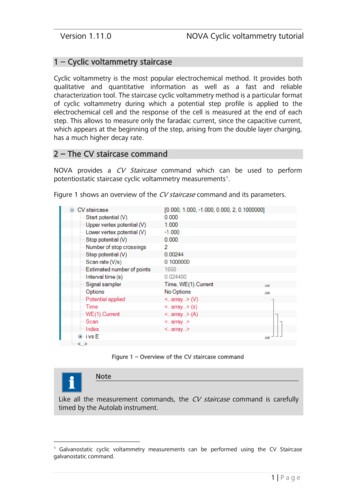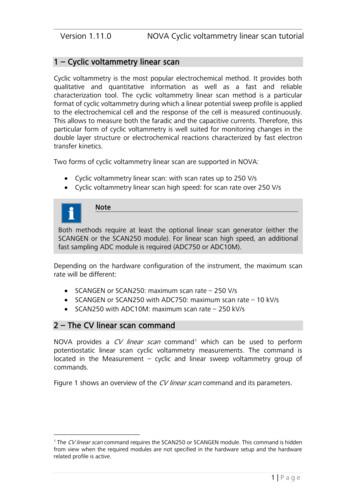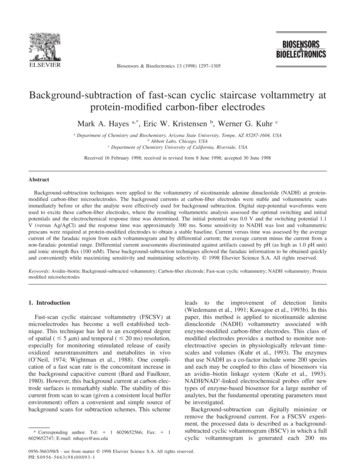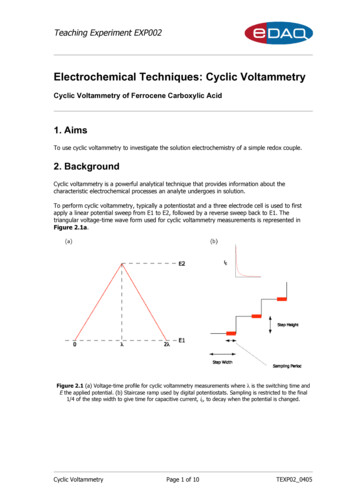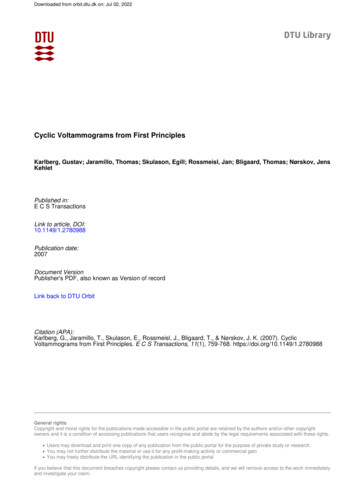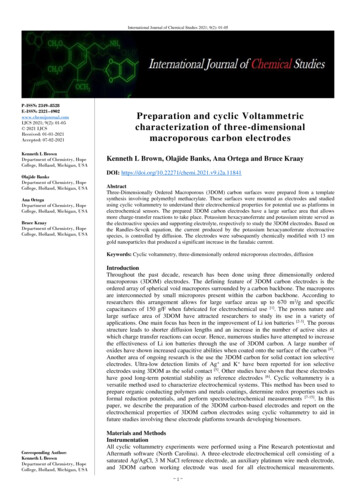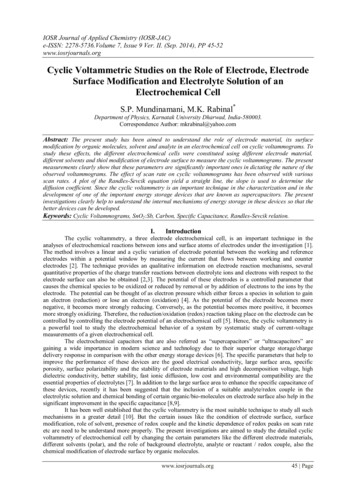
Transcription
IOSR Journal of Applied Chemistry (IOSR-JAC)e-ISSN: 2278-5736.Volume 7, Issue 9 Ver. II. (Sep. 2014), PP 45-52www.iosrjournals.orgCyclic Voltammetric Studies on the Role of Electrode, ElectrodeSurface Modification and Electrolyte Solution of anElectrochemical CellS.P. Mundinamani, M.K. Rabinal*Department of Physics, Karnatak University Dharwad, India-580003.Correspondence Author: mkrabinal@yahoo.comAbstract: The present study has been aimed to understand the role of electrode material, its surfacemodification by organic molecules, solvent and analyte in an electrochemical cell on cyclic voltammograms. Tostudy these effects, the different electrochemical cells were constituted using different electrode material,different solvents and thiol modification of electrode surface to measure the cyclic voltammograms. The presentmeasurements clearly show that these parameters are significantly important ones in dictating the nature of theobserved voltammograms. The effect of scan rate on cyclic voltammograms has been observed with variousscan rates. A plot of the Randles-Sevcik equation yield a straight line, the slope is used to determine thediffusion coefficient. Since the cyclic voltammetry is an important technique in the characterization and in thedevelopment of one of the important energy storage devices that are known as supercapacitors. The presentinvestigations clearly help to understand the internal mechanisms of energy storage in these devices so that thebetter devices can be developed.Keywords: Cyclic Voltammograms, SnO2:Sb, Carbon, Specific Capacitance, Randles-Sevcik relation.I.IntroductionThe cyclic voltammetry, a three electrode electrochemical cell, is an important technique in theanalyses of electrochemical reactions between ions and surface atoms of electrodes under the investigation [1].The method involves a linear and a cyclic variation of electrode potential between the working and referenceelectrodes within a potential window by measuring the current that flows between working and counterelectrodes [2]. The technique provides an qualitative information on electrode reaction mechanisms, severalquantitative properties of the charge transfer reactions between electrolyte ions and electrons with respect to theelectrode surface can also be obtained [2,3]. The potential of these electrodes is a controlled parameter thatcauses the chemical species to be oxidized or reduced by removal or by addition of electrons to the ions by theelectrode. The potential can be thought of as electron pressure which either forces a species in solution to gainan electron (reduction) or lose an electron (oxidation) [4]. As the potential of the electrode becomes morenegative, it becomes more strongly reducing. Conversely, as the potential becomes more positive, it becomesmore strongly oxidizing. Therefore, the reduction/oxidation (redox) reaction taking place on the electrode can becontrolled by controlling the electrode potential of an electrochemical cell [5]. Hence, the cyclic voltammetry isa powerful tool to study the electrochemical behavior of a system by systematic study of current-voltagemeasurements of a given electrochemical cell.The electrochemical capacitors that are also referred as “supercapacitors” or “ultracapacitors” aregaining a wide importance in modern science and technology due to their superior charge storage/chargedelivery response in comparison with the other energy storage devices [6]. The specific parameters that help toimprove the performance of these devices are the good electrical conductivity, large surface area, specificporosity, surface polarizability and the stability of electrode materials and high decomposition voltage, highdielectric conductivity, better stability, fast ionic diffusion, low cost and environmental compatibility are theessential properties of electrolytes [7]. In addition to the large surface area to enhance the specific capacitance ofthese devices, recently it has been suggested that the inclusion of a suitable analyte/redox couple in theelectrolytic solution and chemical bonding of certain organic/bio-molecules on electrode surface also help in thesignificant improvement in the specific capacitance [8,9].It has been well established that the cyclic voltammetry is the most suitable technique to study all suchmechanisms in a greater detail [10]. But the certain issues like the condition of electrode surface, surfacemodification, role of solvent, presence of redox couple and the kinetic dependence of redox peaks on scan rateetc are need to be understand more properly. The present investigations are aimed to study the detailed cyclicvoltammetry of electrochemical cell by changing the certain parameters like the different electrode materials,different solvents (polar), and the role of background electrolyte, analyte or reactant / redox couple, also thechemical modification of electrode surface by organic molecules.www.iosrjournals.org45 Page
Cyclic Voltammetric Studies on the Role of Electrode, Electrode Surface Modification and .II.Experimental SectionAll the chemicals and the reagents are used of analytical grade, these are used as they received withoutfurther purification. Commercially available Camlin 0.7 mm graphite rods (0.07 cm diameter and 6 cm oflength) are used as carbon electrode material to study the cyclic voltammetry. A highly conducting thin films oftin oxide doped with antimony (SnO2:Sb 4 wt.%) on glass surface are also used as electrode materials. Thedetails of synthesis and characterization of these films with antimony composition are discussed elsewhere [11].Ethylene glycol (C2H6O2), potassium nitrate (KNO3) and potassium ferricyanide (K3Fe[CN]6) are obtained fromthe Hi-Media chemicals, India. Heptanethiol (C7H16S) is procured form Sigma-Aldrich chemicals. Thismolecule is used for the surface modification of carbon electrode. For all the washing and reaction purposetripled distilled water (Milli-Q water) is used.For the construction of electrochemical cell, 1 M of KNO3 solution is prepared as an electrolyte and 10mM solution of potassium ferricyanide (K3Fe[CN]6) is prepared in water as a redox couple. To make a standardsolution of this redox couple, in 9.5 ml of KNO3 solution 0.5 ml (K3Fe[CN]6) solution was added. Similarstandard is prepared in ethylene glycol in the place of water. To form electrochemical cell the two electrodeconfiguration cell (Swagelok type configuration) is used, in which working electrode acts as one of the electrodeand shorting of counter electrode with reference electrode acts as another. This two electrodes cell is used tostudy the above mentioned aspects using different electrodes and solvents. Further, the electrochemical graftingof organic molecule (Heptanethiol (C7H16S)) on the carbon surface is carried by passing constant current of 100μA for 2 hours duration in a 50 mM organic molecules solutions and the electrode well rinsed in absoluteethanol to remove the loosely bounded molecules. The measurement of cyclic voltammograms were carried outusing the ACM instruments Gill AC potentiostat device.III.Results And DiscussionIn the present work, to understand the effects of solvent, electrodes and molecular modification ofelectrodes on cyclic voltammograms with respect to K3 Fe[CN]6 is carried out using the two electrode(Swagelok) configuration as an electrochemical cell. As mentioned above, here the reference and counterelectrodes of equipment are shorted as one electrode and working electrode as another electrode. The separationbetween the two electrodes are mentioned almost constant (1 cm) in all the measurements that are reported here.The scientific reliability and the simplicity of two electrode configuration over the conventional three electrodeconfiguration of a electrochemical cell in the study of electrochemical capacitors has been well documented byStoller et al. [12] and others [13]. The best practices on the use of this setup are well summarized by the Stolleret al. [12]. Further, recently we also well testified the reliability of this setup in the characterization ofsupercapacitors [14]. Firstly, two symmetrical carbon electrodes are immersed in electrolyte solution (in thiscase the distilled water and ethylene glycol are used as an electrolyte). The CV curves that are recorded underthe scan rate of 120 mV/s. Figure 1(a) shows the measured CV curves under the potential window ranging from-1 to 1 V. It can be clearly seen that the two scans are quite similar in nature but they differ in their currentlevels. For water, the current level is high and the CV curve is rectangular in shape, the later indicates that thecapacitor behaves as purely electrostatic one. In case of ethylene glycol the current level is less and the curveslightly deviates from a pure electrostatic behavior. These measurements clearly suggest that the solvents doplay a role in controlling the nature and current levels in the cyclic voltammograms and hence in theperformance of electrolytic capacitors. Next, these measurements were repeated with respect to the differentelectrodes that are highly conducting SnO2:Sb films deposited on glass surface. These plots are shown in figure1(b). It is evident from these graphs when compared with the graphs of figure 1(a) that there is clearenhancement in the current levels with respect to SnO2:Sb as compared to carbon electrodes for similarelectrolytes. The change of electrodes from carbon to SnO2:Sb has enhanced the area under the curves that isdirectly proportional to the specific capacitance of an electrolytic capacitor [6,15-17].www.iosrjournals.org46 Page
Cyclic Voltammetric Studies on the Role of Electrode, Electrode Surface Modification and .Figure 1(a): Cyclic voltammograms of carbon electrodes in water (black line) and ethylene glycol solvents (redline) as an electrolyte species.Figure 1(b): Cyclic voltammograms of SnO2:Sb electrodes in water (black line)and ethylene glycol (red line)solvents.The above cyclic voltammograms were repeated by introducing KNO3 to understand the role ofelectrolyte addition on the cyclic voltammograms. These curves are shown in figures 2(a) and 2(b) forsymmetric carbon and SnO2:Sb electrodes. In case of carbon electrodes (figure 2(a)), there is an almost threefold increase in the current levels. A similar change is also observed in case SnO 2:Sb electrodes. However in thelatter case broad humps are clearly observed that leads to greater area under the CV curves.Figure 2(a): Cyclic voltammograms of carbon electrodes in water with KNO3(black line)and ethylene glycolwith KNO3 (red line) mixture as an electrolyte specieswww.iosrjournals.org47 Page
Cyclic Voltammetric Studies on the Role of Electrode, Electrode Surface Modification and .Figure 2(b): Cyclic voltammograms of SnO2:Sb electrodes in water with KNO3(black line) and ethylene glycolwith KNO3(red line) mixture as an electrolyte species.The curves in figure 2(b) strongly deviate from the rectangular nature indicating that the mechanismsother than purely electrostatic also play a rule. The increase in current levels in these plots as compared to plotsof figure 1 are due to ion diffusion, KNO3 in water and EG produces the easy access of K ions reaching theelectrode surface.Figure 3(a): Cyclic voltammograms of carbon electrodes in water with KNO3, potassium ferricyanide(blackline) and ethylene glycol with KNO3, potassium ferricyanide(red line).Figure 3(b): Cyclic voltammograms of SnO2:Sb electrodes in water with KNO3, potassium ferricyanide (blackline) and ethylene glycol with KNO3, potassium ferricyanide (red line). The inset in the figure isenlarged view of the plot between the voltage 0 mV and 600 mV to make the appearance of twopeaks more clear.www.iosrjournals.org48 Page
Cyclic Voltammetric Studies on the Role of Electrode, Electrode Surface Modification and .Further, the above measurements were repeated with carbon and SnO2:Sb symmetric electrodes byintroducing an redox couple that is K3Fe[CN]6. Now the electrolyte between the carbon-carbon and SnO2:SbSnO2:Sb electrodes consist of water/ethylene glycol-KNO3-K3Fe[CN]6 in order to study the cyclicvoltammograms. In case of carbon-carbon electrodes the curves with respect to water and ethylene glycol areshown in figure 3(a). Interestingly in the case of water, the reduction and oxidation peaks are clearly visible inthese curves, the oxidation peak occurs at 103 mV and the reduction peak at -81 mV. In case of standardK3Fe(CN)6 electrolyte oxidation peak occurs at 300 mV and reduction peak at 200 mV with respect to threeelectrode configuration in which glassy carbon as working electrode, Ag/AgCl electrode as reference electrodeand platinum as counter electrode are used. In comparison with this, the standard redox peaks in the present caseare shifted by close to 0.2 V. This could be attributed to the electrode and electrolyte interactions. Whereas forethylene glycol as a solvent these symmetric oxidation and reduction peaks are completely absent. But there is abroad hump as an oxidation peak at 250 mV while scanning from the lower potential to the higher potential. Inboth water and ethylene glycol the additives were completely dissolved and are of equal molarity. The sluggishbehavior of ethylene glycol could be due to its high viscosity that prevents the fast diffusion of ions fromelectrolyte to the electrode surface. The broad hump/peak (in the oxidation side) is due to the release of anelectron from the surface of electrode. The ethylene glycol is preventing the electron to reach the Fe2 destination. In case of water as a solvent Fe3 after losing an electron becomes Fe2 (oxidation) while Fe2 aftergaining one electron becomes Fe3 (reduction). In case of SnO2:Sb-SnO2:Sb electrodes the results are plotted infigure 3(b). For water, the redox peaks are clearly seen with two oxidation peaks one at 90 mV and another at320 mV. The expanded curves of this region is also shown as an inset in figure 3(b) for the clarity, the twobroad peaks are clearly visible. Here the current levels are low as compared to carbon electrodes. The reductionpeak occurs at –105 mV.Figure 4(a): Cyclic voltammograms with different scan rates of carbon electrodes, in water along with KNO3,potassium ferricyanide mixture as an electrolyte.Figure 4(b): Cyclic voltammograms with different scan rates of SnO2:Sb electrodes, in water along withKNO3, potassium ferricyanide mixture as an electrolyte.www.iosrjournals.org49 Page
Cyclic Voltammetric Studies on the Role of Electrode, Electrode Surface Modification and .Figure 5: For carbon electrodes cell the Randles-Sevcik relation is plotted, peak currents for different scan ratesversus the square root of scan rates (red line). It is also plotted in case of SnO2:Sb electrodes (blueline).It has been a well established fact that the reduction and oxidation process in an electrochemicalreaction are kinetic in nature. There is a systematic shift in the redox peak position with voltage scan rate incyclic voltammetric measurements [18,19]. A theoretical model has been developed by Randles and Sevcik topredict how the peak current in reduction /oxidation process dependents on the voltage scan rate [20]. Therelation between these parameters is given by the following formula that is known as Randles-Sevcik equation-------------------- (1)where ip is the peak current of reduction/oxidation process, n is the number of electrons per reactionspecies (for Fe2 it is 1), A is the area of electrode in contact with electrolytic solution, D is the diffusioncoefficient, C is the electrolyte concentration, F is faraday constant, R is Rydberg constant, T is the temperatureand v is the scan rate. This equation clearly predicts that the reduction/oxidation peak position is proportional tothe square root of scan rates. In the present measurements, the Randles-Sevcik relation has been studied forcarbon-carbon and SnO2:Sb-SnO2:Sb electrodes in the presence of water-KNO3-K3Fe[CN]6 electrolyte, sincethis electrolyte clearly exhibits the reduction/oxidation peaks. The scanning is done in the range from 2, 10, 20,50, 80, 100 to 120 mV/s. These curves in case of carbon-carbon electrodes are shown in figure 4(a) and that forSnO2:Sb-SnO2:Sb electrodes are shown in figure 4(b). A clear shift in reduction peaks with scan rate is evidentfrom these plots. In case of former there is single reduction peak in all the scans and in later case only at smallerscan rates this is a single peak but it splits into two peaks from 80 mV/s onward and the two peaks are veryprominent at 120 mV/s. The Randles-Sevcik equation is used to plot the peak current values as function ofsquare root of scan rate, these plots for carbon-carbon and SnO2:Sb-SnO2:Sb electrodes are shown in figure 5,respectively. In both the cases there is almost linear relation between these parameters indicating that in both thecells, the equation (1) is obeyed. However, the fit is better in later case as compared to the former. Further, fromthese plots using equation (1) the ionic diffusion coefficients are estimated. These are 8.101 x 10 -3 and 3.945 x10-3 cm2s-1 in case of carbon-carbon and SnO2:Sb-SnO2:Sb electrodes, respectively. Though the electrolyte issame in both the electrochemical cells, this clearly indicates that the electrode plays an important role incontrolling the ionic diffusion.www.iosrjournals.org50 Page
Cyclic Voltammetric Studies on the Role of Electrode, Electrode Surface Modification and .Figure 6(a): Cyclic voltammograms of bare carbon electrodes (black line) and molecularly modified carbonelectrodes (red line) in water with KNO3 mixture as an electrolyte that is measured under 120mV/s scan rate.Figure 6(b): Cyclic voltammograms of bare carbon electrodes (black line) and molecularly modified carbonelectrodes (red line) in water with KNO3, potassium ferricyanide mixture as an electrolyte andthe scan is recorded with 120 mV/s.As mentioned above, the chemical binding of certain molecules and biomolecules significantlyenhances the current level and generates new peaks in the cyclic voltammograms [8,9]. In order to study thiseffect in case of carbon electrode, heptanethiol molecules are chosen to bind on the surface of electrode byelectrografting process. First, the chemically modified carbon-carbon electrodes are used in water-KNO3electrolyte. These measurements are plotted in figure 6(a), for comparison the curve of bare (chemicallyunmodified) electrodes is also shown. The significant difference between these curves is that there is largeenhancement in the current levels at given potential. For bare electrode it is observed that 0.001 mA/cm2 is thecurrent order at 1 V, while for the molecularly modified electrodes show the current order of 0.07 mA/cm2 at 1V that is almost one order of magnitude more. It clearly shows that the molecular binding on electrode surfacehas a major role in controlling the current in cyclic voltammograms. Further, these measurements are repeatedin the presence of redox couple K3Fe[CN]6. These curves are shown in figure 6(b) for both the bare and thechemically modified carbon electrodes. Once again the chemically modified electrode surface enhances thecurrent level by more than one order. The redox peaks are significantly shifted to higher voltage as compared tobare electrodes. In case of chemical modification the reduction occurs at 600 mV whereas the oxidation occurswww.iosrjournals.org51 Page
Cyclic Voltammetric Studies on the Role of Electrode, Electrode Surface Modification and .at 100 mV. All these results suggest that the ion diffusion in vicinity of electrode-electrolyte interface getsenhanced after chemical modification. This clearly demonstrates that the molecular modification of electrodesurface in an electrochemical cell is an important aspect to enhance the specific capacitance.IV.ConclusionsIn the present work a systematic investigations are carried out to study the role of electrodes, solventsand the chemical modification of electrode surfaces on the nature of current-voltage curves of cyclicvoltammetry. These measurements clearly suggest that the nature and level of currents in cyclic voltammogramsclearly depend on the many factors. These include the nature of electrode material, the type of solvents and scanrates. The expected reduction/oxidation peak intensity and position a redox couple also dependent on solventand electrode material. Further, the chemical binding of certain molecules on electrode surface is very importantin the enhancement of current levels and shift in the reduction/oxidation peak position. This gives raise to higharea under cyclic voltammogram and hence a high value of specific capacitance of a supercapacitor. Thisstrategy would be an interesting aspect in the development of supercapacitors for the modern applications.AcknowledgementsOne of the authors SPM would like to thank UGC, India, for helping the financial support in the 8].[19].[20].Princeton Applied Research, Applied Instrument Group, Basics of voltammetry and polarography, Application Note P-2, 1-12.J. Wang, Analytical Electrochemistry, Chapter 2, John Wiley & Sons (2000).R.S. Nicholson and I. Shain, Theory of stationary electrode polarography, single scan and cyclic methods applied to reversible,irreversible and kinetic systems, Anal. Chem, 36, 1964, 706-723.D.K. Gosser, Jr., Cycic Voltammetry: Simulation and Analysis of reaction mechanisms, VCH Publishers (1993).A.J. Bard and L.R. Faulkner, Electrochemical Methods: Fundamental and Applications, Second Edition, John Wiley and SonsPublishers (2001).P. Simon and Y. Gogotsi, Materials for electrochemical capacitors, Nature Materials, 7, 2008, 845-855.G. Wang, L. Zhang and J. Zhang, A review of electrode materials for electrochemical supercapacitors, Chem. Soc. Rev, 41, 2012,797-828.Q. Wu, Y. Sun, H. Bai and G. Shi, High-performance supercapacitor electrodes based on graphene hydrogels modified with 2aminoanthraquinone moieties, Phy. Chem. Chem. Phys, 13, 2011, 11193-11198.M. Khairy and S.A. El Safty, Hemoproteins–nickel foam hybrids as effective supercapacitors, Chem. Comm, 50, 2014, 1356-1358.B.E. Conway, Electrochemical Supercapacitors: Scientific Fundamentals and Technological Applications, (Kluwer, 1999).Uma Nerle, R.M. Hodlur and M.K. Rabinal, A sharp and visible range plasmonic in heavily doped metal oxide films, MaterialsResearch Express, 1, 2014, 015910, 1-17.M.D. Stoller and R.S. Rouff, Best practice methods for determining an electrode materials performance for ultracapacitors, Energyand Environmental Science, 3, 2010, 1294-1301.S. Ratha and C.S. Rout, Supercapacitor Electrodes Based on Layered Tungsten Disulfide-Reduced Graphene Oxide HybridsSynthesized by a Facile Hydrothermal Method, ACS Appl. Mater. Interfaces, 5, 2013, 11427-11433.S.P. Mundinamani and M.K. Rabinal, Molecular modification of highly degenerate semiconductor as an active electrode to enhancethe performance of supercapacitor, J.Physics.D: Appl Phy, 2014 Communicated.P. Simon and A. Burkey, Nanostructured carbons: Double layer capacitance and more, The electrochemical Interface, Spring 2008 ,38-43.C. Zhao, W. Zheng, X. Wang, H. Zhang, X. Cui and H. Wang, Ultrahigh capacitive performance from both Co(OH) 2/grapheneelectrode and K3Fe(CN)6 electrolyte, Scientific Reports, 3:2986, 2013, 1-6.W. Chen, Z. Fan, L. Gu, X. Bao and C. Wang., Enhanced capacitance of manganese oxide via confinement inside carbonnanotubes, Chem. Comm, 46, 2010, 3905-3907.X. Wang, Q. Xiang, B. Liu, L. Wang, T. Luo, D. Chen and G. Shen, TiO 2 modified FeS nanostructures with enhancedelectrochemical performance for lithium-ion batteries, Scientific Reports, 3:2007, 2013, 1-8.B. Zhang, Y. Yu, Z. Huang, Y-B. He, D. Jang, W-S. Yoon, Y-W. Mai, F. Kang and J-K. Kim, Exceptional electrochemicalperformance of free standing electrospun carbon nanofiber anodes containing ultrafine SnOx particles, Energy Environ. Sci, 5, 2012,9895-9902.S.R. Das, S.B. Majumder and R.S. Katiyar, Kinetic analysis of the Li ion intercalation behaviour of solution derived nanocrystalline lithium manganate thin films, J. Power Source,139, 2005, 261–268.www.iosrjournals.org52 Page
The cyclic voltammetry, a three electrode electrochemical cell, is an important technique in the analyses of electrochemical reactions between ions and surface atoms of electrodes under the investigation [1]. The method involves a linear and a cyclic variation of electrode potential between the working and reference .


